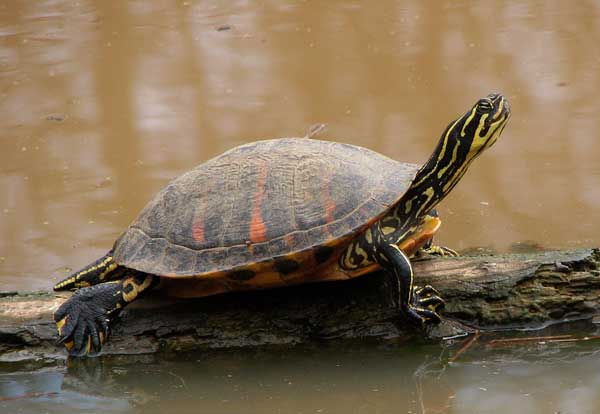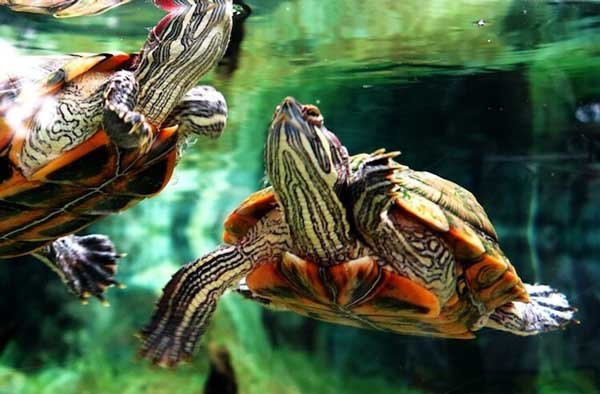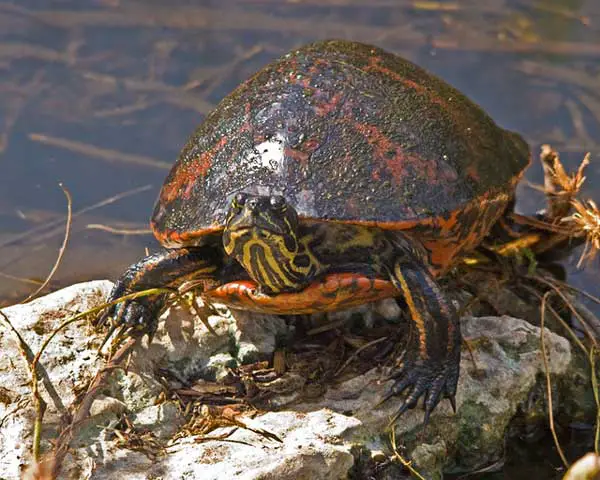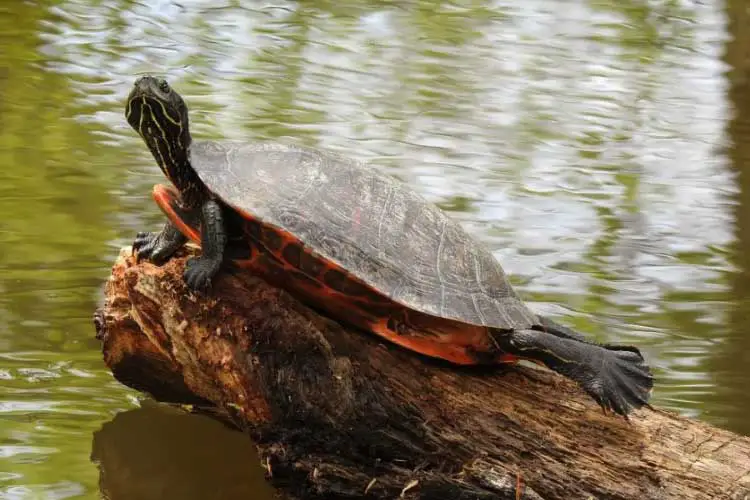Florida Red-Bellied Turtle: Size, Lifespan, Care Guide
The Florida red-belied turtle is not only an attractive but also sociable species of turtle, making it a popular choice of pet turtle in the U.S. However, it requires special care to enable it to live happily and healthily for years. So, how do you take good care of your Florida redbelly turtle?
To take good care of your Florida red-bellied turtle, provide it with a spacious enclosure with swimming space and a basking area with a heat lamp and UV light. The redbelly also requires a high-quality diet made up of 95% vegetation and 5% animal protein. With good care, your red-bellied pet turtle can last for 40+ years.
Read our guide below for more tips on how to take care of your Florida red-bellied turtle. You’ll discover the proper tank setup, what to feed the turtle, how frequently to feed it, how big the turtle gets at maturity, care for the baby redbelly turtle, and so much more.
Florida Red-Bellied Turtle Overview:
Contents
- Common names: Florida red-bellied turtle, Florida Red Belly Turtle
- Scientific name: Pseudemys nelsoni
- Size: 7 to 9 inches (males), 11 to 13 inches (females)
- Diet: Herbivorous
- Distribution: Okefenokee Swamp extending from southern Georgia west to Florida
- Difficulty of care: Moderate
- Lifespan: 40 to 60 years
Are Florida red-bellied turtles good pets?
These turtles make good pet turtles and are quite popular in the US. The fact that they aren’t demanding makes them suitable beginner turtle owners.
However, you must ensure you meet all the special requirements of this turtle to keep them happy and healthy for years to come.
For instance, you should provide this Cooter turtle with a large enclosure with plenty of swimming area and a basking platform.

You should also provide it with a proper diet and take it for routine vet checkups to ensure it is always in good health.
Before you own this turtle, check what your local laws state about its ownership and whether it’s prohibited to keep as a pet.
How big do Florida red bellied turtles get?
These turtles have medium-to-large-sized bodies—just like all the other Cooters. As with most of the other turtle species, the female red-bellied turtles usually grow larger than the males.
Typically, a female redbelly turtle has an average size of 11 to 13 inches while a male turtle has an average size of 7 to 9 inches.

Despite the size difference, the males and females look alike. However, the males feature thicker and longer tails (up to twice their shell length) which makes them easy to identify.
Florida Red-Bellied Turtle Tank setup:
The perfect tank setup for your Florida redbelly Cooter should mimic its natural habitat in the wild.

Follow the guidelines below to achieve a suitable habitat for your redbelly turtle:
Proper tank size
You’ll need a large tank for your redbelly turtle. This is due to their large size plus the fact that they’re strong swimmers and like spending most of their time swimming in the waters. Get your turtle a tank that’s at least 75 to 100 gallons (the bigger the tank, the better).
Basking spot
Since the redbelly is a semi-aquatic turtle, it also needs to take some time off swimming. You can facilitate this by providing it with a basking platform. You should create a dry land or a basking perch that is easily accessible for your pet and is stable and spacious enough to accommodate its size.
Filtration
You’ll also need to install a water filter in the tank to help keep your water clean and save you from the hassle of cleaning your tank more often. Remember, a clean environment is essential for your turtle’s health and keeps away ammonia as well as other harmful toxins from your turtle tank.
Heat source
A perfect indoor redbelly cooter turtle tank setup should also be maintained at healthy temperatures for this species. The water temperature should be 70-75 degrees F while that of the basking area should be 85-95 degrees.
Positioning a thermometer in the water and near the basking area will help you monitor these temperatures which are crucial for your turtle’s survival.
UVB light
Make sure your turtle has access to UVB light. This is crucial to enable your pet to properly metabolize the calcium needed for healthy shell development. Install the light in the basking area and change it every 6 months to ensure continued UVB rays emitting efficiency.
Florida Red Bellied Turtle Diet
The Florida redbelly cooter is a strong herbivore and 95% of its diet is made up of vegetation. The rest 5% should be made up of animal proteins.
In simpler words, a healthy diet for your red-bellied turtle should contain both vegetation and proteins.
Some of the suitable foods to consider include aquatic plants, leaf spinach, lettuce, and other leafy greens.

For the protein part, you can provide your pet with commercial turtle crickets, pellets, smelts, earthworms, small fish, mussel meat, etc.
As the general rule of thumb goes, give your turtle food 1-2 times every day. And make sure the quantity of food is as big as the turtle’s head.
Florida Red Bellied Turtle Aggressiveness
The redbelly turtle isn’t considered an aggressive species both in the wild and in captivity. It is rare to hear of this cooter biting or attacking a human.
Due to this docile behavior, you can comfortably keep this turtle in pairs or groups of males and females without worrying about them hurting each other.
However, note that your redbelly may show some level of aggression if it feels threatened or when trying to protect its eggs or hatchlings.
Florida Red Bellied Turtle Common Health Problems
Some of the most common health issues likely to catch up with your red-bellied turtle include vitamin A deficiency, respiratory infections, intestinal parasites, metabolic bone disease, and obesity.
These illnesses can cause serious health can bring serious complications to your turtle’s health and even cost it its life.
Luckily, they can be avoided by taking good care of your pet, providing it with good habitat, and a healthy diet. Also, taking your pet for regular checkups by your vet will help keep away these health issues.

An experienced vet can also easily detect them when still in the early stages and stop them right in their tracks.
Also, if you suspect something is off with your turtle, you should consult your vet ASAP for diagnosis and treatment. Some of these health issues can be treated or reversed when caught in the early stages.
Florida Red Bellied Turtle Lifespan in captivity
The average lifespan of the Florida redbelly turtle is around 40 years, though it can hit up to 60 or more years.
The secret to ensuring your turtle hits such a long lifespan is giving it good care.

If you want your pet turtle to live for many years, make sure you provide him with a proper diet, a good habitat that mimics its natural environment, and good water quality.
Plus, make sure you take him for regular vet checkups to keep his health in check. Good health translates to long life!
Florida Red Bellied Turtle Baby Care
If you have a baby redbelly turtle, you should also take good care of it by providing it with suitable housing. We recommend around a 10-gallon tank for the baby turtle.
But keep in mind that the young turtle will soon outgrow its small tank and require you to upgrade to a bigger one.
Just like for the adult turtles, you’ll need to equip the tank with a basking platform as well as other crucial equipment including the heat source, filtration system, and UVB light source.

The baby redbelly’s diet is omnivorous, though it also tends to consume small quantities of insect prey. So, you should feed your little friend a diet that contains both plant and animal protein.
Above all, you should monitor your baby turtle’s health and growth regularly. And be sure to consult a veterinarian if you notice anything abnormal in your red-bellied pet turtle.
Final Verdict
Before you bring home that redbelly turtle pet, make sure you understand all its special needs and be fully committed to taking good care of it so that it stays happy and healthy. If you follow the tips we’ve discussed above on how to take good care of your redbelly turtle, it will live a happy and healthy life, and for more years.
Caring for your Florida redbelly turtle includes providing it with a suitable habitat with plenty of swimming space, a basking spot, and UVB light. The temperatures for the enclosure should also be maintained at healthy levels. Feed your turtle a balanced diet. And keep its health in check by taking it to your vet yearly for a routine checkup.



